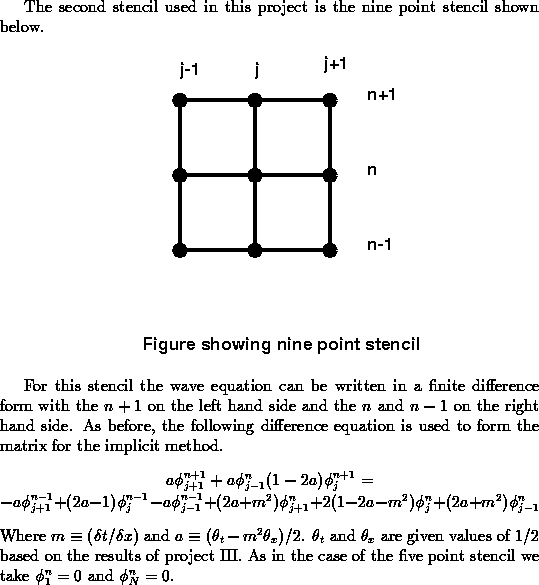



Evolution with Reflecting boundaries
Given the initial data discussed in project II and parameters discussed
earlier an evolution is carried out to 200 steps. This corresponds to a
time of 2.00 units. The pulse moves to the right and when it hits the
boundaries it is reflected as expected. The evolving pulse decays rapidly
in time. The rate of decay is faster for coarser grids.
The convergence factor is seen to decay rapidly below 2. We would have
expected, from our analysis from project III, that the convergence factor
should remain around 2.0 but due to the dissipation of the wave we get the
decay.
In the movies that follow I show an evolution with 801 points and 201 points.
The yellow curve shows the 201 point evolution and the blue the 801.
 MPEG movie of evolution of moving pulse with reflecting boundaries for the five point scheme.
MPEG movie of evolution of moving pulse with reflecting boundaries for the five point scheme.
Reflecting boundary convergence test
The graph below shows the convergence factor
as a function of time. The convergence factor decays as a function of time
At t=1.0 the variation is due to boundary conditions.


Evolution with Reflecting boundaries
Given the initial data discussed in project II and parameters discussed
earlier an evolution is carried out to 200 steps. This corresponds to a
time of 2.00 units. The pulse moves to the right and when it hits the
boundaries it is reflected as expected. Note that compared to the five point
stencil this evolution does not dissipate as drastically. The convergence
factor stays near an even 4.08 except when the waves hit the boundaries at
t=1 and t=2 units. For these runs I took theta_t = 1/2 and theta_x = 1/2.
In the movies that follow I show an evolution with 801 points. The first
shows the function phi itself and the second the truncation error estimate in
phi. The truncation error estimate was obtained by subtracting phi_2h from
phi_h. It is interesting to note that the truncation error estimate consists of
two sets of pulses which are opposite in sign. At t=2.0 They cancel. Perhaps
this might aid in explaining the drop in the convergence factor at that time.
 MPEG movie of evolution of moving pulse with reflecting boundaries for the nine point scheme.
MPEG movie of evolution of moving pulse with reflecting boundaries for the nine point scheme. MPEG movie showing the truncation error estimate in time.
MPEG movie showing the truncation error estimate in time.
Reflecting boundary convergence test
The graph below shows the convergence factor
as a function of time. At t=1.0 and t=2.0 there are drops in the convergence
factor due to the fact that the truncation error drops to zero at t=1.0 and
t=2.0. The explanation can be that (phi_4h - phi_2h) goes to zero faster than
(phi_2h - phi_h) at t=1.0,2.0,3.0,... and so the ratio goes to zero. An
alternative, suggested by S. Liebling, is to subtract four times
(phi_2h - phi_h) from (phi_4h - phi_2h) and show that as a function of time.
